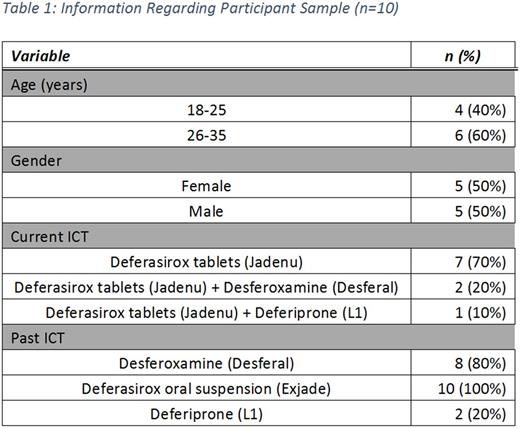Abstract
Background: Adherence to iron chelation therapy (ICT) is essential to the health and survival of patients with transfusion-dependent thalassemia. In recent years, the advent of oral chelators has improved the ease with which ICT is administered. Despite these changes, adherence to ICT among patients with thalassemia remains suboptimal. Age has been found to be associated with ICT adherence, and young adult patients have been found to be at higher risk of nonadherence compared to other age groups. Young adulthood is a critical transitional stage, both with regards to life pursuits, as well as to clinical and self-management of chronic illness. Consequently, there is a need to study the underlying factors related to adherence within the context of young adulthood.
Objective: To identify the barriers and promoters to ICT adherence from the perspective of young adult patient with thalassemia.
Methods: Ten transfusion-dependent patients with thalassemia (Table 1) were recruited at UCSF Benioff Children's Hospital Oakland (BCHO) to participate in individual interviews. Participants were ages 18 to 35 years and prescribed some type of ICT. A semi-structured interview guide was developed based on existing literature, and participants were asked questions regarding their general experience of thalassemia, the transition from childhood to adulthood as related to thalassemia, and promoters and barriers to ICT adherence. Interviews were audio-recorded, transcribed, and imported into NVivo software for analysis using grounded theory methodology. Codes were developed iteratively and classified into overarching themes, which were then mapped to form a cohesive framework.
Results: The young adult patients described thalassemia as comprehensively impactful on their lives. Consequently, patient narratives focused largely on the minimization of the thalassemia impact , which was an overarching driver both to adherence and nonadherence to ICT; nonadherence resulted from a conception of ICT administration as a departure from normalcy, while adherence resulted from a conception of ICT administration as a necessary facilitator of normalcy. Conceptions of chelation as a necessity to normalcy was informed by four driving factors: (1) a high degree of integration of thalassemia into participants' lives, (2) a low degree of perceived burden from the chelation process , (3) a view of the chelation process as independent or self-motivated , and (4) an effective understanding of ICT necessity to prevent iron overload. The inverse of each of these four factors promoted a view of ICT as a hindrance to normalcy which facilitated nonadherence. The driving factors in turn were found to be influenced by external mediators including chelation type/characteristics, degree of chelation habituation, life stage characteristics, clinical support, and parental involvement/support.
Conclusion: This study provides a framework that identifies four driving factors whose alignment is necessary for ICT adherence. By mapping how these core factors are influenced by external mediators, this framework provides an understanding of key indicators and pathways to adherence and nonadherence for young adults with thalassemia. For instance, the relative ease of oral chelators and increased habituation of chelation may decrease the perceived burden of the chelation process, improving adherence. Extensive parental involvement in managing chelation during childhood may be more complexly related to adherence - decreasing the burden of the chelation process, yet hindering the perception the patients' view of chelation as an independent process. Clinicians may play a crucial role in facilitating perception of ICT as necessary and efficacious by tracking iron status with patients - an effective motivator that also appeals to patients' desire to view adherence as a largely independent and self-motivated process. Furthermore, clinical staff like health navigators or community health workers who lower systemic barriers to care may be influential in enabling integration of thalassemia into daily life, promoting adherence. Ultimately this framework provides guidance for future empirical and interventional studies addressing ICT adherence. Further research is also needed to explore perceptions and practices regarding ICT adherence from the perspective of parents and health care providers of young adults with thalassemia.
No relevant conflicts of interest to declare.
Author notes
Asterisk with author names denotes non-ASH members.


This feature is available to Subscribers Only
Sign In or Create an Account Close Modal